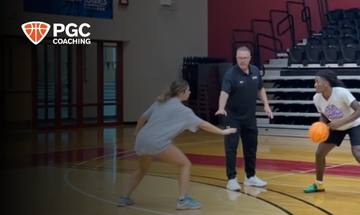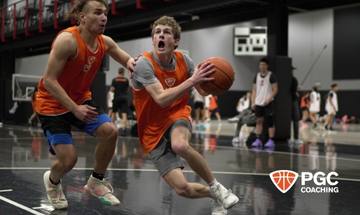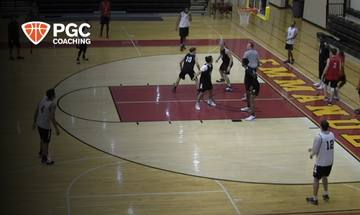How to Teach Defensive Rebounding: A Smart, Game-Ready Drill for Basketball Coaches
One of the most overlooked and under-coached parts of the game is defensive rebounding. Yet, nothing matters if you can’t secure the ball after a defensive stop. This basketball rebounding drill flips the switch, helping your players build habits that transfer directly into games.
Let’s walk through one of our favorite ways to train rebounding instincts and habits.
Plus here are a few other defense resources you may want to add to your arsenal as well…
- Smarter Closeouts: How to Defend Shooters, Drivers, and Complete Players
- Competitive 4-on-4 Game Drill to Build Decision-Making, Shot Selection, and Defensive Grit
- How to Teach On-Ball Defense That Actually Works in Games
Why This Basketball Rebounding Drill Works
This basketball rebounding drill focuses on the essentials:
- Boxing out with purpose
- Reading and reacting to the ball off the rim
- High-pointing the rebound
It’s a simple progression, but it’s designed to mimic game-like chaos. We’re not just telling players to “box out”—we’re training them to react, find the ball, and go finish the possession.
Drill Breakdown: Defensive Rebounding Progression
1. Start on defense:
Assign a player to defense. When the shot goes up, their job is simple: hit, find, and go.
- Hit the offensive player and create separation.
- Find the ball by reacting quickly to the bounce.
- High-point the rebound—don’t let it hit the ground.
2. High Point Emphasis
It’s not enough to just track the ball. Teach your players to go get it at the highest point. “You’ve got to react to the ball—don’t just run to where you think it will be,” is something you’ll hear me say over and over.
3. Switch Between Offense and Defense
Alternate players so they get both defensive and offensive rebounding reps. Even offensive rebounding becomes a teaching point—how do they get away from the blockout? Are they crashing with intent?
4. Make It Competitive
Want to add another layer? Make it a battle. Reward the rebound. Turn it into a one-on-one break. Just don’t let it be passive.
Coaching Points to Reinforce
- Don’t run until you see it. Train players to read the ball, not just assume where it’s going.
- React, then go get it. Teach urgency after contact.
- High point the basketball. The rebound doesn’t belong to the tallest—it belongs to the one who goes and gets it.
See the Basketball Defensive Rebounding Drill in Action
Most players don’t rebound well because they haven’t formed the habit. This basketball rebounding drill builds it, rep after rep. The more your team commits to basketball rebounding drills like this one, the more stops you’ll actually finish in games.
It’s about building the habits of a complete, connected defender—someone who adds value on every possession.
And that might be the difference between winning and losing.
FAQ: Teaching Defensive Rebounding in Basketball – Habits That Win Possessions
Q: Why is defensive rebounding such a critical skill in basketball?
A: In the most simple terms, it ends the possession. Without it, even the best defensive effort means nothing. A team that can’t consistently secure the rebound will give up second-chance points, lose momentum, and miss out on transition opportunities.
Make rebounding a daily emphasis to turn stops into possessions.
Q: What does “high-pointing the rebound” mean?
A: High-pointing the rebound means grabbing the ball at the peak of its arc, before it falls into a crowd or bounces. It:
- Prevents tip-outs and second chances
- Builds confidence in traffic
- Helps shorter players out-rebound taller ones by reacting faster
Train players to jump early, extend arms fully, and grab it cleanly at the peak.
Q: How do you teach players to box out effectively?
A: Boxing out effectively involves three clear steps:
- Contact – Make physical contact immediately after the shot.
- Seal – Use leverage to keep your opponent away from the rim.
- Pursue – Release and go aggressively after the ball.
The key is effort plus timing—players must hit early, hold position, and react with urgency.
Reinforce box-out cues every rep: “Hit, hold, hunt.”
Q: How can I make rebounding drills more game-like?
A: Add these layers:
- Live offensive crashers: Don’t make it easy.
- Game-start reactions: Rebound and immediately push into transition.
- Scoring incentives: Reward the rebound with a one-on-one drive or shot.
These game-like additions increase engagement, simulate pressure, and reinforce decision-making.
Start with structure—then add chaos and competition.
Q: What are common rebounding mistakes young players make?
A: Some of the most common mistakes include:
- Watching the shot instead of boxing out
- Letting the ball hit the ground
- Jumping late or mistiming the leap
- Chasing the ball instead of securing position
These habits can be corrected with consistent, focused reps that teach players to hit first, locate the ball, and go get it.
Film and review rebounding reps to help players build awareness and timing.
Q: How do you keep players engaged during rebounding drills?
A: Turn rebounding into a competitive challenge:
- Use scorekeeping or time limits
- Create rebound-and-score scenarios
- Track individual rebound wins per session
A little competition goes a long way in building toughness and attention to detail.
Gamify your drills to maintain energy and accountability.
Q: Should guards be included in defensive rebounding drills?
A: Absolutely. Guards play a vital role in:
- Crashing from the perimeter
- Scrapping for long rebounds
- Initiating the transition off the rebound
Teach all five players to rebound—and your team’s defense becomes complete.
Train guards to rebound with purpose and start the break.
Q: How often should teams practice defensive rebounding?
A: Defensive rebounding should be practiced every week, if not daily. It can be:
- Built into warm-ups
- Combined with defensive shell drills
- Reinforced with situational rebounding games
Frequent reps lead to reliable in-game habits.
Schedule consistent rebounding reps to close out stops and win possessions.
It’s a great visual breakdown of hitting, finding, and high-pointing the ball under game-like conditions.
Study the demo with your staff or players before your next rebounding session.
Final Note
If your team struggles to finish defensive possessions, don’t just yell “box out”—teach it with purpose, urgency, and habits that stick. Drills like this one build rebounders you can count on when it matters most.
If you’d like to explore even more resources just like these, grab a free 7-day trial to get access to our members-only content.
– TJ
Check out all of our defensive drills and strategy resources here.
About the Author
TJ Rosene
Coach TJ Rosene, head coach of the Emmanuel University men’s basketball team and Director of Coach Development for PGC Coaching, has spent his career shaping young athletes both on and off the court. With over 400 career wins and 12 seasons of 20+ wins, Rosene’s coaching experience is extensive and impressive. His teams have competed in six national championship games, winning three NCCAA National Championships. Under his leadership, the Lions made their NCAA Division II debut in 2018-19 and quickly captured two season titles and one tournament title, along with an appearance in the NCAA Division II Sweet 16 in 2021.
Rosene’s success expands far beyond the scoreboard. He’s been named National Coach of the Year three times and Conference Carolinas Coach of the Year twice. But for Coach Rosene, the most meaningful part of his work is the lasting impact he has on his players’ lives. As he puts it, “Coaching is a rare opportunity to shape and mold the lives of young people. It’s a privilege that I never take for granted.”
New Here?
Get coaching tips and tools like these delivered to your inbox each week!
Join the 15,000 coaches we’ve assisted…

Related Articles
How to Teach On-Ball Defense That Actually Works in Games
Build lockdown defenders with 5 simple on-ball habits every coach needs to teach. Start winning more defensive battles today!
45 Scramble Down: Build Defensive Communication, Rotations, & Recovery in One High-Impact Drill
Master defensive chaos with the 45 Scramble Down Drill — boost your team’s communication, quick rotations, and clutch stops under pressure. Ready to take your defense to the next level?
Competitive 4-on-4 Basketball Drill to Build Decision-Making, Shot Selection, & Defensive Grit
Train like you play. This 4-on-4 drill builds real-game toughness, smart decisions, and winning habits—every possession counts.
About PGC
PGC Basketball provides intense, no-nonsense basketball training for players and coaches. Our basketball camps are designed to teach players of all positions to play smart basketball, be coaches on the court, and be leaders in practices, games and in everyday life.
We combine our unique PGC culture with a variety of teaching methods and learning environments to maximize the learning potential of those that attend our sessions. In addition to spending 6-7 hours on the court each day, lessons will be reinforced through classroom sessions and video analysis.
Our goal at PGC is to empower you with the tools to fulfill your basketball dreams, while also assisting you in experiencing the joy of the journey.
To learn more about PGC Basketball, including additional basketball training tips and videos, visit our YouTube Channel or find us on Facebook, Instagram, and Twitter.






Share This Post